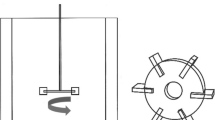Abstract
Turbulence is known to enhance growth in microalgae. We studied the possible effects of the extra inorganic carbon supplied to the cultures when air bubbling is the source of turbulence. A set of experiments was carried out to separate the effects of the subsidiary action of agitation on growth from those due to possible carbon enrichment from air CO2 when air bubbling was the source of mixing. It was found that air bubbling does not induce an increase of the concentration of inorganic carbon in HCO −3 -enriched growth media, and that no differences appear between air-bubbled and CO2-free air-bubbled cultures. On the other hand, photosynthetic O2 was accumulated in the medium in non-mixed cultures, which showed higher respiration and lower photosynthetic rates, probably due to photoinhibition induced by oversaturation of O2. Growth rate, maximal cell density and photosynthetic efficiency were higher in aerated cultures than in non-aerated ones.
Similar content being viewed by others
References
Aguilera, J., Jiménez, C., Rodríguez-Maroto, J.M. and Niell, F.X. 1994. Influence of subsidiary energy on growth ofDunaliella viridis Teodoresco: the role of extra energy in algal growth. Journal of Applied Phycology 6:323–330.
Belyaev, V.I. 1992. Modelling the influence of turbulence on phytoplankton photosynthesis. Ecological Modelling 60: 11–29.
Ben-Amotz, A. and Avron, M. 1989. The biotechnology of mass culturingDunaliella for products of commercial interest. In: R.C. Cresswell, T.A.V. Rees and N. Shah (Eds) Algal and Cyanobacterial Biotechnology, pp. 90–114, Longman Scientific and Technical Press, London.
Ben-Amotz, A., Shaish, A. and Avron, M. 1989. Mode of action of the massively accumulated β-carotene ofDunaliella bardawil in protecting the alga against damage by excess irradiation. Plant Physiology 91: 1040–1043.
Booth, W.A. and Beardall, J. 1991. Effects of salinity on inorganic carbon utilization and carbonic anhydrase activity in the halotolerant algaDunaliella salina, (Chlorophyta). Phycologia 30: 220–225.
Edwards, G. and Walker, D. 1983. C3, C4: Mechanisms, and Cellular and Environmental Regulation of Photosynthesis. Blackwell Scientific Publications, Oxford. 542 pp.
Fresenius, W., Quentin, K.E. and Schneider, W. (Eds). 1988. Water Analysis. Springer-Verlag, Berlin, 804 pp.
Garcá-Sánchez, M.J., Fernández, J.A. and Niell, F.X. 1994. Effect of inorganic carbon supply on the photosynthetic physiology ofGracilaria tenuistipitata. Planta 194: 55–61.
Goyal, A. and Tolbert, N.E. 1989. Uptake of inorganic carbon by isolated chloroplasts from air-adaptedDunaliella. Plant Physiology 89: 1264–1269.
Grobbelaar, J.U. 1994. Turbulence in mass algal cultures and the role of light/dark fluctuations. Journal of Applied Phycology 6: 331–335.
Jiménez, C. Niell, F.X. and Fernández, J.A. 1990. The photosynthesis ofDunaliella parva Lerche as a function of temperature, light and salinity. Hydrobiologia 197: 165–172.
Laws, E.Z., Terry, K.L., Wickman, J. and Challup, M.S. 1983. A simple algal production system designed to utilize the flashing light effect. Biotechnology Bioengineering 25: 2319–2335.
Poole, R.W. 1974. An Introduction to Quantitative Ecology. McGraw-Hill Kogakusha, Ltd., Tokyo, 532 pp.
Powles, S.B. 1985. Photoinhibition of photosynthesis induced by visible light. Annual Review of Plant Physiology 35: 15–44.
Ramazanov, Z. and Cárdenas, J. 1992. Inorganic carbon transport across cell compartments of the halotolerant algaDunaliella salina. Physiologia Plantarum 85: 121–128.
Richmond, A. and Becker, E.W. 1986. Technological aspects of mass cultivation. A general outline. In: A. Richmond (Ed.) Handbook of Microalgal Mass Culture pp. 245–264. CRC Press, Boca Raton.
Richmond, A. and Vonshak, A. 1978.Spirulina culture in Israel. Archiv für Hydrobiologie, Beih., Ergebn. Limnol. 11: 274–280.
Richmond, A., Vonshak, A. and Arad, S. 1980. Environmental limitations in outdoor production of algal biomass. In: G. Shelef and C.J. Soeder (Eds) Algae Biomass, pp. 65–72. Elsevier/North-Holland Biomedical Press, Amsterdam.
Vonshak, A. 1987. Biological limitations in developing the biotechnology for algae mass cultivation. Science l'eau 6: 99–103.
Winokur, M. 1948. Growth relationship ofChlorella species. American Journal of Botany 35: 118–129.
Author information
Authors and Affiliations
Rights and permissions
About this article
Cite this article
Jiménez, C., Mercado, J., Aguilera, J. et al. Effect of turbulence and inorganic carbon supply on growth ofDunaliella viridis Teodoresco. International Journal of Salt Lake Research 4, 223–232 (1995). https://doi.org/10.1007/BF02001492
Issue Date:
DOI: https://doi.org/10.1007/BF02001492




